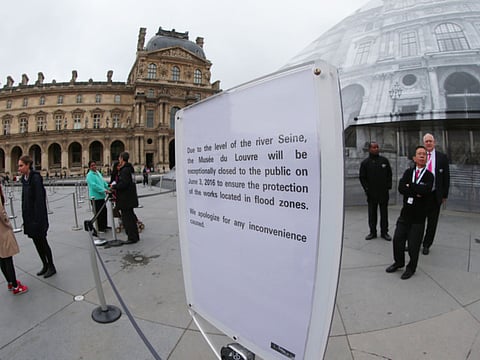The masterpieces I’d save from the floods
The rising waters of the Seine beg the question of all art lovers: Which artwork would you rescue?

They’ve closed the Louvre. Good! Not “good” in the most obvious sense. The paintings in the basement are at risk from the swelling waters of the Seine, which laps against the walls of the collection, and clearly that’s not good at all. But “good” because all those lazy culture-vultures, desperate for a peep at La Gioconda, might stir themselves into finding other great works to gawp at.
In Paris, “that movable feast”, as Hemingway described the city, it is never difficult to find paintings that repay the time you are prepared to give them. If there were eight days in every week, and 53 weeks in each year, Paris would still offer the curious art-lover something fresh; the key word being “curious”. Sadly, many people who shuffle dutifully into art galleries lack curiosity. The joy of looking at paintings, and developing a critical intelligence, is one of life’s supreme joys.
Alan Bennett has written touchingly of being a trustee of the National Gallery, and being able to walk through the rooms at night with only the paintings for company. It was, he thought, the greatest honour of his life. On one occasion in my life I was able to share Bennett’s joy, spending an hour in the Art Institute of Chicago one November morning under the tutorial wing of Tony Jones, chancellor of that famous institute’s art school. It was a glorious hour but it can spoil a person for life. It all leads to an overwhelming question: If you could save only one painting, which would it be? It’s impossible to give an answer you would never want to revise, but that’s part of the fun. Bernard Levin, in his book, Enthusiasms, eventually went for Vermeer’s Milkmaid in Amsterdam.
The last time I was in the Rijksmuseum a group of tourists wandered past it, clicking away, without giving it a moment’s reflection. Why, one wonders, did they bother going in? Let’s put a few cards on the table, like Cezanne’s joueurs des cartes. My favourite big collection in the world can be found in Vienna, the mighty Kunsthistorisches Museum. My favourite small collection, small being relative, is the Frick on East 70th Street in Manhattan.
The Frick, which calls itself a collection, not a museum or gallery, may have the greatest concentration of masterpieces to be found anywhere. Then there are the favourite rooms: The Kandinskys in Munich’s Lenbachhaus; the Caspar David Friedrichs on the top floor of the Alte Nationalgalerie in Berlin; the Murillo street urchins at the Alte Pinakothek in Munich; the Titians in the Kunsthistorisches Museum; the small but well-formed gathering of Impressionists at the Courtauld Institute overlooking the Thames at Somerset House.
Fine collections do not have to be grand. Pallant House in Chichester, and the Barber Institute on the campus of Birmingham University, have plenty of good things to admire. The Brucke Museum, in the western suburbs of Berlin, has a wonderful array of work by the Dresden artists of the early 20th century. The Isabella Stewart Gardner Museum in Boston has riches galore. We all ride high on our hobby horses. I happen to love Chardin’s still lives, Cezanne’s pears, Sargent’s ladies, Hals’s gentlemen, Corot’s boatmen, Rothko’s bars of red and black, Daubigny’s spring meadows, and Whistler’s nocturnes. I prefer Lawrence to Gainsborough, Pissarro to Sisley, Matisse to Picasso, de Kooning to Pollock. In my personal mythology may be found Durer, Goya, Waldmuller, Degas, Pieter de Hooch and Lovis Corinth. You will not find the Pre-Raphaelites, the Symbolists, the Futurists, or anything by Francis Bacon. Were I to choose the greatest work of all then it might be Rembrandt’s self-portrait, dressed as an emperor, which hangs in the Frick. But it is so overpowering it would be hard to live with. So it is back to Vienna, to the Kunsthistorisches Museum, for the paintings I would save, for what they are and what they represent. If you have eyes to see then you will, at some stage of your life, realise that Velazquez and Rembrandt are the supreme painters; the ones who delve deepest and see furthest.
Born seven years apart, in 1599 and 1606, they stand at the very summit of human achievement, and in Vienna you can see their work in its Olympian glory. In the Velazquez room there is the 1659 portrait of Philip Prospero, son and heir to Philip IV of Spain, aged two; he died two years later. Walk in a straight line across the building, into the Dutch rooms, and you will see Rembrandt’s portrait of his son, Titus, painted two years earlier.
Titus, who is reading a book, was 16 when Rembrandt composed it. He died 11 years later, 12 months before his father. No artists did more to honour mankind, yet in these intimate works they were not striving for the moon. Here are tender portraits of a young man in the bloom of adolescence and an infant who barely lived at all. Velazquez, Rembrandt; Rembrandt, Velazquez. First equal; then, now and always.
— The Telegraph Group Limited, London, 2016
Sign up for the Daily Briefing
Get the latest news and updates straight to your inbox



